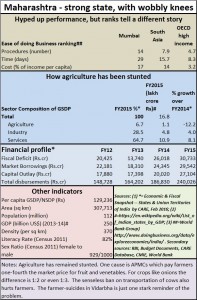http://www.freepressjournal.in/will-maharashtra-alienate-rural-votes-rn-bhaskar/794453
Will Maharashtra alienate rural votes?
The finance minister may have made major announcements to boost agriculture. But in BJP ruled Maharashtra, agriculture remains one of the most exploited sectors. Some of these measure could grievously hurt the ruling party’s votebanks. The state itself could stumble badly.
First the caveats. Make no mistake: Maharashtra is still formidable. It is the third largest state in terms of land mass in India (Rajasthan and Madhya Pradesh are larger). It is the biggest in the country in terms of GDP. It is the most industrialised state. Its Economic Survey 2015 talks about how it remains the highest contributor to the nation’s industrial GDP and its port traffic.

Second, as a recent report from CARE points out, the state is already trying to achieve some ambitious goals. It has commenced with geographic information system (GIS) mapping of land banks, which will allow it to monitor subsidies to agriculture more carefully. It will also allow land titles to be recorded centrally, rendering more difficult any tinkering with land records by local bureaucrats and legislators. It has streamlined procedures and timelines for obtaining various infrastructure connections – for electricity, railways and even roadways. It has also introduced e-governance initiatives in its law and judiciary departments and created specialized courts for handling commercial disputes.
But there are some extremely worrying indicators. First, the state has been growing at just barely 7.5%. Compare this against 13% for Andhra Pradesh, 18% for Karnataka, 15% for Tamil Nadu and 15.5% for Gujarat. Clearly, Maharashtra is slipping.
Then look at the ease of doing business in Maharashtra (see chart). The numbers are not very flattering. Whether it is real estate approvals, the Shops and Establishment or the Food & Drugs Administration (FDA), the stench of corruption is always around.
But agriculture could be the worst casualty. The state has constantly been shortchanging its farmers. The price agricultural producers get for fruit and vegetables from the politician-controlled APMCs (Agricultural Produce Market Committee) is meagre. The producer gets only one-fourth, even one-fifth, of the market price.
For non-perishable products like onions the city retail price can be double or triple the price the farmer gets. .
What is galling is that APMC’s earnings are not reflected as the state government’s earnings. They are not subject to CAG audits. These are funds that politically well-connected members of the committee can use the way they please. And this figure runs into several thousand crore rupees each year.
Another good indicator is the price that the farmer gets for milk produced at his farms. Unlike Gujarat, Maharashtra has been slow in forming new milk cooperatives which could protect the price the farmer gets. Instead, middlemen pick up milk from farmers at Rs.16-20 a litre. Even the existing milk cooperatives in Maharashtra exploit the farmer. As against a price of Rs.28-30/litre that Gujarat’s cooperatives pay out for milk, Maharashtra’s cooperatives pay out only around Rs.26. Gujarat’s cooperatives pay farmers the price for milk every day – often directly into their bank accounts. In Maharashtra payout is often once in 10 days – at best once a week. The milk industry in this state is being hurt in other ways as well. The state’s own milk brand Aarey has been allowed to languish. And most legislators and developers have begun eyeing the landbanks and properties that Aarey owns.
Agricultural production thus remains stunted, because agricultural earnings remain low. That could also explain why agriculture accounts for just 7% of Maharashtra’s GSDP (gross state domestic produce) compared to the national figure of 17%. What is worse is that while agriculture for the country declined by 0.2% in 2014-15 (it grew by 1.1% in 2015-16), in Maharashtra agriculture suffered a (minus) 12% decline.
Instead, services in the state grew by 8%. But that could also be because the middlemen took much of the money that should have gone to farmers. A loss of 7% GSDP for agriculture means that almost Rs. 1.1 lakh crore could have got transferred from agriculture to services.
The cow slaughter ban too has hurt Maharashtra’s farmers. True states like Gujarat have this ban in place for decades. But the ban does not prohibit sale or transport of cows and bulls. In Maharashtra, even sale and transport of such animals is banned.
So what does a farmer in drought prone Marathawada or Vidarbha do? He cannot get water for his cows. He cannot sell them outside the state. He cannot even transport them. Yet the state pays him no subsidy for the losses he makes. This is truly insane! It hurts the farmer even more during a year of drought.
Finally, look at the skewed development. Almost 20% of the state’s people stay on just 2% of its land – in and around Mumbai, and in Pune. Together just these territories accounted for over 45% of the state’s income, pointing to the lopsided development the state has pursued for the past several decades.
As the state’s own economic survey points out “The major contributors to the state income are Mumbai (22.1%), Thane (13.3 %) and Pune (11.4 %). These districts together contribute 46.8 per cent to GSDP. Maximal share in Agriculture & Allied Activities sector of GSDP comes from Nashik (10.4 %).” Even in the services sector, Mumbai accounts for 27% followed by Thane (14.1%). That should have freed up land for agriculture. But even here the news is dismal.
Yet, do remember that 55% of Maharashtra’s population is rural. That’s where the votes lie. Unless the state learns to reward its farmers, expect the next elections to be one where the farmers will vote out existing leaders.



































COMMENTS